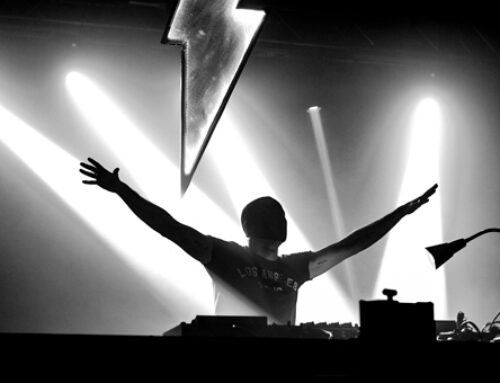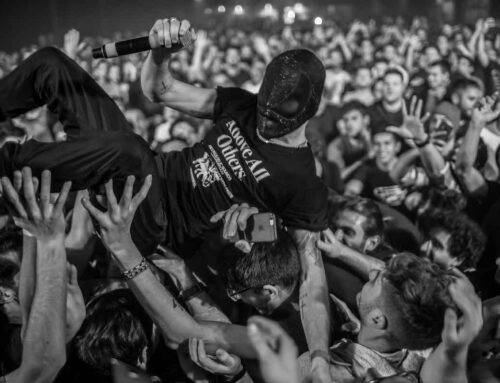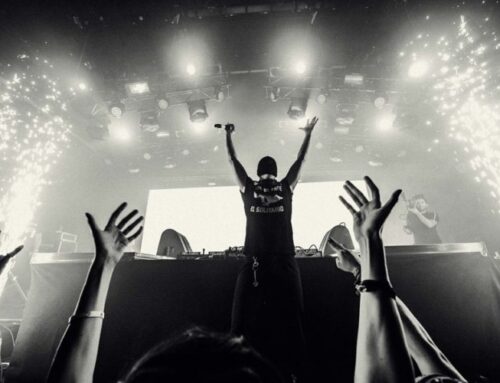[vc_row][vc_column][vc_column_text]
Catch Steve Aoki in Las Vegas as a Hakkasan-resident DJ, and you’ll get all the glitz and champagne glamour of a modern electronic dance spectacle. Gogo dancers in bejeweled bikinis dance under geometric LEDs as confetti rains over thousands of well-dressed partiers. It’s so common place these days, it’s a cliché — but no one predicted such opulence 10 years ago, when the long-haired Dim Mak leader screamed into a microphone in an Italian basement while Sir Bob Cornelius Rifo of The Bloody Beetroots‘ mother banged on the door.
That screaming and banging made it onto the final cut of a song called “Warp.” It took about five minutes to make, but it’s gone on to be what Rifo calls the most important song of his career. Its raw, lo-fi, guitar-crunch rowdiness became a rallying cry for a generation of punks-turned-electro addicts. It’s been streamed more than 15 million times on Spotify, while an unofficial YouTube upload of the official video has more than 36 million plays. It even led to Rifo’s eventual collaboration with his hero Paul McCartney. Now, it gets a special vinyl reissue on Dim Mak in celebration of its 10-year anniversary.
“It was a different time,” Rifo tells Billboard Dance. “I don’t want to say it was better, but we were starting a revolution… It was all about the music and the energy. We didn’t have any algorithms at that time. We were our reach, because people knew that if you were going to go to a Bloody Beetroots DJ set or Steve Aoki DJ set, you found that energy, and that energy came from the punk roots we had.”
In honor of the 10-year anniversary reissue, Billboard Dance spoke to both Rifo and Aoki to get the inside story on how “Warp” was made. Read the oral history of the late-aught electro anthem below.
Rifo: Everything started for The Bloody Beetroots at the beginning of 2007. We started releasing music and some DJs like Erol Alkin started to pick it up. We started to get pretty popular around the blogosphere and MySpace. Steve dropped me a message on MySpace saying, “Hey, Bob, I want to sign you on my label.”
Aoki: Until MSTRKRFT, [Dim Mak] was signing pretty much all indie rock, like Bloc Party and a lot of British rock artists that were coming through to America at the time — but I was DJing electro, so of course we need to start signing electro acts. MSTRKRFT was the first big one. I was looking for other acts in that space to sign, and then I came across Bob’s remixes. They were like the come up, because at that time, Crookers was very popular, Justice was massive, Boys Noize was killing it – and here’s this Italian duo. I was like, “Wow, they’re crushing on the remixes,” and then I started speaking with them. It was an instantaneous friendship.
Rifo: I said, I don’t need a label. I’m already big without a label… but I met Steve, and he was such nice dude. Just because he’s such a nice dude, I signed.
Aoki: We signed them for a multiple-album deal. it was like the second largest signing we’d done at the time. They started working on Romborama, the album. One of the first first big records, they’d made was a song called “Dimmakmmunication.” It was like their celebration of signing to Dim Mak, too. That was a massive record in the underground scene.
Rifo: I did “Cornelius,” which was a pretty dope track. It really started to be successful. We started having songs on charts. Shit was becoming real. [Steve and I] were touring around Europe together, and at some point we stopped on my mom’s house in Bassano del Grappa. I couldn’t afford a house, and I had a studio set up in my mom’s basement.
Aoki: During that week, we created a hardcore band called Rifoki, which is Bob Rifo and Steve Aoki, so it’s called Rifoki. In the daytime, we were going to a real studio and rehearsing, writing and recording a punk album called Sperm Donor. I was singing and writing the lyrics. I was also writing some of the guitar parts as well. Bob was playing guitar as well. We got Congorock, another electro DJ who was a punk kid at heart, playing bass. We were going back to our roots. We made a five song EP together in five days.
Rifo: [Back at my mom’s house], I opened this synthesizer called Sylenth1, and say “Steve, listen to this. It’s called hoover. Listen how great it sounds if you push the limit.” Steve loves it, so we go for a hook, and because dinner was almost ready, my mom was pounding the door. I say, “Let’s go quickly, like, ‘1, 2, 3, 4.’” A couple of shouts, and a dance song. I was recording Steve, my mom was pounding the door saying “guys, dinner is ready.” We had to leave the studio and I said to Steve, “This is it, this is the song.” This entire bullshit took five minutes, and this is the most important song of my career. I do a few versions, “Warp 1.9” and “Warp 7.7.”
Aoki: If you add those numbers together it’s 1977. We were both born in 1977, so it has some history in who we are and our friendship.
Rifo: I got a call from Steve saying will.i.am wanted to sing on “Warp.” I thought about it for a second, but I called Steve back and said I didn’t want to do it. I respect will.i.am for the music he does, but I don’t think he should be on this reccord. This is our legacy. This is you and I, and the way we made the song is so unique. We got to keep this legacy between me and you. I start playing it, because I want to see that reaction of the people, and every time I play “Warp,” people [go] fucking nuts.
Aoki: That period of time, electro was a fusion of unbridled angst and energy and noise. The philosophy was the most important thing, and that really harkened back to my early days in punk and hardcore; it was this underground current of kids coming together that love this rebellious sound. We kind of cut away from the mainstream commercial electronic space, and we created our own little world. That became a very, very loud voice.
Rifo: Steve wanted to do a video, and we were both in Italy touring again. I got this this guy called Francesco Calabrese, who directed one of my garage punk videos with my old band. I said. “Frankie, do you want to jump on this? I don’t know any other directors, and we have no money. I don’t know how to pay you, but I’ll give you the credit.” He said yeah, and got a high-speed Phantom camera, he casted people — even my old old girlfriend. It took like three hours… It’s not even on my or Steve’s YouTube. It’s like some random dude who uploaded it, and it has millions of plays.
Aoki: The energy was still that punk energy, so the shows were just raucous. stage diving, crowd surfing, screaming on the mic. The music production was very aggressive and mixed like distorted guitars, just heavy. That’s when I found my voice in the scene, and “Warp” had that. It was loud and unadulterated. I was screaming. You don’t have many songs [like that], even in that era of time. It really was like a bat signal to other kids that wanted that — and it became like a beacon to [bring] the culture together.
Rifo: We were punks. I think we’re still punks. We didn’t give a fuck, and that’s the way it works.
The rest, as they say, is history. Rifo released a Best Of…Remixes LP with Dim Mak, then signed with Ultra Music for The Bloody Beetroots’ sophomore LP Hide. That album featured many crossover collaborations, including Tommy Lee, Peter Frampton and Paul McCartney. Rifo remembers his experience recording in McCartney’s windmill-turned-studio in Essex, England as one the best and most surreal moments of his life.
“Paul gets into the room and looks at me saying, ‘You’re the guy who screams?’” Rifo laughs. “He asked me, ‘Would you like to have a bagel with vegemite?’ And I said ‘Yeah, of course. Whatever you like, I’ll eat it.’ I hate vegemite … but I ate it all. You can’t say no to Paul.”
Rifo was also impressed with the ex-Beatle’s studio prowess. “If you listen to the very end of the song, there’s like a choir that Paul created from scratch while he was recording, which made me lose my mind,” he remembers. “That’s the moment I realized that I was working with Paul McCartney.”
In 2017, The Bloody Beetroots released The Great Electronic Swindle featuring more rock crossover collaborations, but now, he wants to return to his club music roots. Later this month, Rifo will release Heavy, a new EP from The Bloody Beetroots featuring solo tracks and collaborations with Ephwurd, and previously released electro banger “Fkn Face” with Dr. Fresch.
The single carries much of the same color and attitude of The Bloody Beetroots’ late-’00s releases — fitting, as “Warp” celebrates its 10-year anniversary with a special re-release on Dim Mak. The special re-release comes in a four-track package, featuring both “Warp 1.9” and “Warp 7.7” as well as “Warp 1977,” and a 2016 reboot called “Warp 2.0.” It’s available on streaming platforms and as a limited-edition vinyl via Dim Mak. Listen to the 10-year anniversary release below.
[/vc_column_text][/vc_column][/vc_row]







© THE BLOODY BEETROOTS